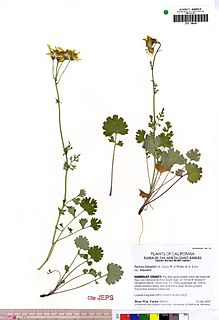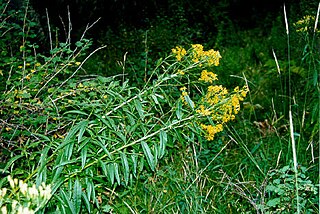
Callistephus is a monotypic genus of flowering plants in the aster family, Asteraceae, containing the single species Callistephus chinensis. Its common names include China aster and annual aster. It is native to China and Korea. and it is cultivated worldwide as an ornamental plant in cottage gardens and as a cut flower.

Lupinus arboreus, common name yellow bush lupine (US) or tree lupin (UK), is a species of flowering plant in the legume family Fabaceae.

Heracleum mantegazzianum, commonly known as giant hogweed, is a monocarpic perennial herbaceous flowering plant in the carrot family Apiaceae. H. mantegazzianum is also known as cartwheel-flower, giant cow parsley, giant cow parsnip, or hogsbane. In New Zealand, it is also sometimes called wild parsnip or wild rhubarb.

Brachypodium sylvaticum, commonly known as false-brome, slender false brome or wood false brome, is a perennial grass native to Europe, Asia and Africa. It has a broad native range stretching from North Africa to Eurasia.

Centaurea calcitrapa is a species of flowering plant known by several common names, including red star-thistle and purple starthistle. It is native to Europe but is rarely found there, it is known across the globe as an introduced species and often a noxious weed. The species name calcitrapa comes from the word caltrop, a type of weapon covered in sharp spikes.

Vinca major, with the common names bigleaf periwinkle, large periwinkle, greater periwinkle and blue periwinkle, is a species of flowering plant in the family Apocynaceae, native to the western Mediterranean. Growing to 25 cm (10 in) tall and spreading indefinitely, it is an evergreen perennial, frequently used in cultivation as groundcover.

Carduus acanthoides, known as the spiny plumeless thistle, welted thistle, or plumeless thistle, is a biennial plant species of thistle in the sunflower family (Asteraceae). The plant is native to Europe and Asia and introduced in many other areas, where it is sometimes considered an invasive species.

Gazania linearis is a species of flowering plant in the daisy family known by the common name treasure flower. It is native to southern Africa, particularly South Africa, but it can be found in other parts of the world with similar climates where it has taken hold as an introduced species, such as in California and New Mexico in the United States; Australia; and New Zealand, where it has been classified as a weed. The species typically grows on grassy and rocky hillsides. The Gazania Linearis is classified as invasive in some areas, including California.

Psephellus dealbatus is a species of Psephellus native to the Caucasus Mountains. It is widely cultivated as an ornamental perennial.

Buphthalmum is a genus of flowering plants in the aster family, Asteraceae. There are 2 or 3 species. They are native to Europe, and B. salicifolium is in cultivation and has been introduced elsewhere.
Pulicaria paludosa is a species of flowering plant in the aster family known by the common name Spanish false fleabane. It is native to Europe, particularly Spain and Portugal, and it is known as an introduced species in California, where it grows as a weed on roadsides and other damp, disturbed areas. It is an annual, biennial, or perennial herb growing a few centimeters tall to well over a meter tall from a rhizomatous root system. The leaves are alternately arranged with blades in a variety of shapes from linear to oblong or oval. The herbage is coated in soft hairs. The inflorescence bears many flower heads. Each head has narrow, pointed, hairy phyllaries, a large dense center of many yellow disc florets, and a short fringe of many rectangular yellow ray florets, which are only about 2 millimeters long each. The fruit is an achene tipped with a pappus of bristles.
Pyrrocoma carthamoides is a species of flowering plant in the aster family known by the common name largeflower goldenweed. It is native to western North America from British Columbia to northeastern California to Wyoming, where it is known from grassland, woodlands, forests, barren areas, and other habitat. It is a perennial herb growing from a taproot and producing one or more stems to about half a meter in maximum length, the stems reddish-green and leafy. The largest leaves are at the base of the stem, measuring up to 20 centimeters long, lance-shaped with spiny sawtoothed edges. Leaves higher on the stem are smaller and hairier. The inflorescence is a single flower head or a cluster of up to four. Each bell-shaped head is lined with phyllaries each up to 2 centimeters long. It has many yellow disc florets surrounded by a fringe of yellow ray florets up to 7 millimeters long; ray florets are occasionally absent. The fruit is an achene which may be well over a centimeter in length including its pappus.

Packera bolanderi is a species of flowering plant in the aster family known by the common names Bolander's ragwort and seacoast ragwort. It is native to the west coast of the United States from Washington to northern California, where it grows in wet coastal forests and woodlands. There are two varieties of the species which differ slightly in morphology and habitat occupied; these varieties have been considered separate species by some authors. The var. bolanderi has thicker leaves, occurs farther south, and occupies more open types of habitat, than does var. harfordii. This plant in general is a perennial herb producing one to three stems up to half a meter tall. The basal leaves have blades up to 12 centimeters long which are divided into several lobes and borne on long, thin petioles. Leaves growing farther up the stem are smaller and have more lobes on their blades. The inflorescence contains several flower heads, each lined with dark green phyllaries. The head contains many golden yellow disc florets and generally either 8 or 13 yellow ray florets each over a centimeter long. The fruit is an achene tipped with a pappus of bristles.

Senecio elegans is a species of flowering plant in the aster family known by the common names redpurple ragwort, purple groundsel, wild cineraria and purple ragwort.
Packera ganderi is a rare species of flowering plant in the aster family known by the common name Gander's ragwort. It is endemic to southern California, where it is known from a few occurrences in San Diego and Riverside Counties.

Packera multilobata is a species of flowering plant in the aster family known by the common name lobeleaf groundsel. It is native to the western United States from California to Wyoming to New Mexico, where it is common and can be found in many habitat types.
Packera pauciflora is a species of flowering plant in the aster family known by the common name alpine groundsel. It is native to northern North America, where it can be found in parts of western and eastern Canada and the northwestern United States. It grows in subalpine and alpine climates, such as mountain meadows.

Senecio serra is a species of flowering plant in the aster family known by the common names tall ragwort and sawtooth groundsel. It is native to the western United States, where it can be found in several types of habitat, including sagebrush and woodlands. It is a perennial herb producing a single erect stem or a cluster of stems from a branched, woody caudex. The plant can exceed two meters in height. It is hairless in texture, with young plants sometimes appearing fuzzy, and green to red-tinged in color. The leaves have lance-shaped blades up to 20 centimeters long borne on short petioles, the leaves occurring evenly all along the stems. The inflorescence is a spreading array of many flower heads, each lined with green- or black-tipped phyllaries. The heads contain yellow disc florets and 5 to 8 yellow ray florets each under a centimeter long.

Senecio sylvaticus is a species of flowering plant in the aster family. It is variously known as the woodland ragwort, heath groundsel, or mountain common groundsel. It is native to Eurasia, and it can be found in other places, including western and eastern sections of North America, as an introduced species and an occasional roadside weed. It grows best in cool, wet areas. It is an annual herb producing a single erect stem up to 80 centimeters tall from a taproot. It is coated in short, curly hairs. The toothed, deeply lobed leaves are up to 12 centimeters long and borne on petioles. They are evenly distributed along the stem. The inflorescence is a wide, spreading array of many flower heads, each lined with green- or black-tipped phyllaries. The heads contain yellow disc florets and most have very tiny yellow ray florets as well.

Artemisia frigida is a widespread species of flowering plant in the aster family, which is known as the sunflower family. It is native to Europe, Asia, and much of North America. In parts of the north-central and northeastern United States it is an introduced species.





















